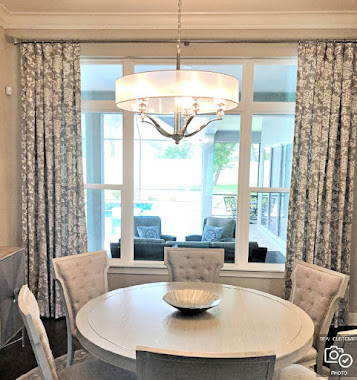Custom Drapery No-No's
When it comes to custom drapery, there are a few things that you want to avoid.
Estimating Measurements: Do not ballpark. Do not assume. Do not estimate. Take a moment to ensure that the accuracy of the finished sizes is correct. Double check widths and lengths with blue painters tape.
Skimping On The Fabric: You don't want to cut corners when it comes to custom window treatments. Skimping on fabric will make drapery look cheap. Full and luxurious is the goal when creating that designer look. A good rule of tumb for operating drapery (as opposed to stationary side panels) is one and a half times to two times the width of the rod.
Not Selecting A Length: Choose an architectural detail to align the drapery with. For example, using the bottom part of the window sill, an inch above the baseboard heater, or a 1/4 inch above the floor. Anything else can look like a mistake.
Not Adding Lining: Lining serves a very important function for drapery. Not only does it help keep its shape regardless of heat and humidity, it protects the face fabric from sun damage. Silk fabrics should always have the addition of interlining. Drapery should last 10 years or longer when properly lined.
Mounting Hardware In The Wrong Place: Do not install hardware brackets into window trim or frame. Trim is installed with finishing nails. Drapery hardware should be secured with the same care as heavy, oversized wall decor. Be sure to read to read all instructions prior to installation.
Going With Trends: Stay true to your style, not the latest fads or trends. Not all design ideas work the same in different spaces. Don't force something that you don't feel comfortable with.
Estimating Measurements: Do not ballpark. Do not assume. Do not estimate. Take a moment to ensure that the accuracy of the finished sizes is correct. Double check widths and lengths with blue painters tape.
Skimping On The Fabric: You don't want to cut corners when it comes to custom window treatments. Skimping on fabric will make drapery look cheap. Full and luxurious is the goal when creating that designer look. A good rule of tumb for operating drapery (as opposed to stationary side panels) is one and a half times to two times the width of the rod.
Not Selecting A Length: Choose an architectural detail to align the drapery with. For example, using the bottom part of the window sill, an inch above the baseboard heater, or a 1/4 inch above the floor. Anything else can look like a mistake.
Not Adding Lining: Lining serves a very important function for drapery. Not only does it help keep its shape regardless of heat and humidity, it protects the face fabric from sun damage. Silk fabrics should always have the addition of interlining. Drapery should last 10 years or longer when properly lined.
Mounting Hardware In The Wrong Place: Do not install hardware brackets into window trim or frame. Trim is installed with finishing nails. Drapery hardware should be secured with the same care as heavy, oversized wall decor. Be sure to read to read all instructions prior to installation.
Going With Trends: Stay true to your style, not the latest fads or trends. Not all design ideas work the same in different spaces. Don't force something that you don't feel comfortable with.





